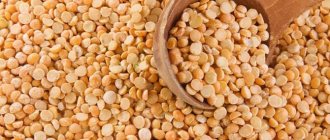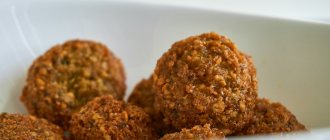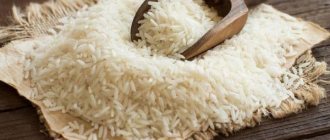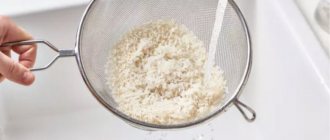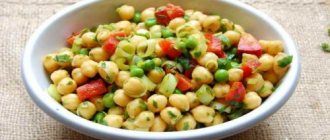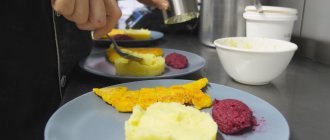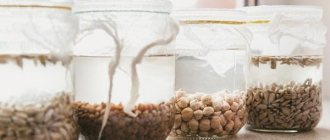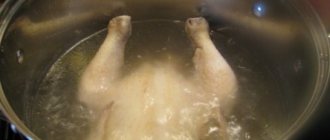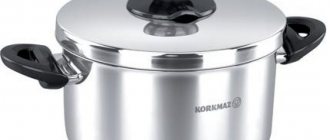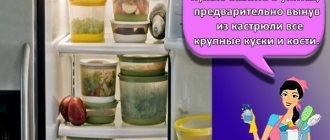Pre-soaking legumes can significantly reduce their further cooking. In addition, this procedure will allow you to control the process of preparing soups to which you plan to add peas.
If the beans are not pre-soaked and immediately added to the soup, then other vegetables may be overcooked, and the peas will not have time to become soft. Or vice versa - the meat may not reach the state of readiness and remain tough, and the peas will already turn into porridge.
In addition, some chefs believe that soaking peas helps prevent bloating.
What water should you soak in?
Peas should only be soaked in cold water. If you pour hot water over it and leave it for several hours, this will cause the product to sour and the finished dish will be spoiled by the unpleasant taste of legumes. The problem is that spoiled beans look no different from normal ones.
For soaking, it is better to use filtered or bottled water so that the peas do not absorb harmful impurities from the water that flows from the tap. If it is not possible to use a filter or bottled water, take boiled water.
To further speed up the process of softening the peas, you can add a little baking soda to them. But not sugar or salt, as some housewives advise: they, unlike soda, are not able to speed up the softening process of legumes.
Adding soda to peas will reduce the content of vitamin B1 in it and slightly worsen the taste of the product. Therefore, before adding soda, you will have to choose whether you want a healthy or a quick dish.
Now let's look at the soaking process in more detail:
- To begin, place the required amount of cereal in a deep bowl and sort through. It is necessary to remove all debris, as well as split and spoiled peas, so that they do not spoil the taste of the dish.
- Now rinse the peas several times until the water runs completely clear.
- Fill the peas with cool water so that it covers them by 1–2 cm.
- When the soaking process is completed, the peas must be washed again.
We recommend: Deception, body kit and extra hassle: I’ll tell you why I don’t buy bags of potatoes
Benefits of pea soup
It has been proven that peas are good for humans - they speed up metabolism and have a beneficial effect on processes important to life. Properties of the culture:
- contains a large amount of protein;
- high nutritional value;
- essential microelements;
- magnesium contained in peas helps absorb calcium;
- fresh vegetables are useful for diseases of the genitourinary system;
- acts as a prevention of diabetes mellitus; content of vitamins B and E;
- contains iron.
But there are also contraindications to the use of this type of crop – diseases of the digestive system.
How long to soak?
Several factors influence how long you spend soaking:
- the selected pea variety (Idaho variety cooks fastest);
- whole peas take longer to soften (6–8 hours) than split peas (20 to 180 minutes);
- the temperature of the room in which the legumes are located (in a warm room, soaking can be reduced by 2–3 hours, in a cold room it can be extended to 9 hours);
- By adding soda, the soaking process is also shortened.
Determining the readiness of peas is quite simple: if they have doubled in size, you can start cooking.
Preparation
It would seem that nothing could be simpler - put the peas in a pan and cook. However, it happens that the dish turns out hard or burns, and its taste does not please the cook. It turns out that even such a simple matter has its own rules. And the first of them is proper preparation of cereals.
Do I need to soak peas before cooking soup?
To date, breeders have developed many different varieties that behave differently when cooked. And yet, rare varieties, for example, “Idaho”, “Oregon”, boil well without soaking. Basically, the housewife will have to suffer a lot if she does not take care of the preliminary swelling of the peas. The cooking time will increase, and the peas may remain tough.
Soaking peas for soup overnight or at least for a few hours is required for other reasons. Many people are wary of peas because they suffer from increased gas formation after eating them. Flatulence occurs because some of the substances are not completely absorbed in the small intestine and enter the large intestine, where fermentation occurs. Soaking helps to reduce this phenomenon, during which the beans produce enzymes that accelerate the process of fiber processing. In addition, when soaked, beans remove those substances that interfere with the absorption of beneficial food components.
How long to soak peas for soup depends on their size and variety. If you plan to prepare puree soup, then it is more advisable to take crushed cereal, which will quickly turn into a viscous mass.
Whole peas look good in a clear broth against the background of finely chopped herbs and bright vegetables (bell peppers, carrots, tomatoes) added after stewing.
How to soak peas for soup
To get good quality peas, you need:
- Sort out the measured volume of cereal from garbage and defective peas (dark or with traces of insect pests), but it is better to immediately choose high-quality cereal.
- Rinse well until the water runs clear.
- Place in a deep container and fill with water so that it rises 2 cm above the surface.
- Leave in a cool place for several hours, avoiding stirring, which can lead to souring, especially if the air temperature is too high.
- If necessary, you can add cold water.
- Wash the peas again and start cooking.
How to quickly soak peas for pea soup
If you need to speed up the preparation time for cereals, you can use one of the following methods during soaking:
The first option is to change the water 2-3 times.
The second option is to add a teaspoon of baking soda, which removes enzyme blockers that accelerate the softening of peas, and also additionally prevents the occurrence of flatulence.
There is a third recipe - heat the cereal in a dry frying pan for 15 minutes.
How to quickly soak peas?
If you need to prepare a dish very quickly, choose split or as fresh as possible peas and soak them in warm (but not hot!) water with the addition of soda.
- Thoroughly wash and sort the legumes.
- In a separate bowl, stir soda at the rate of 2 teaspoons per 2 liters of water.
- Pour the resulting mixture into the beans and add more warm water so that the liquid covers the peas by a couple of centimeters.
- After soaking is completed, be sure to rinse the peas thoroughly to get rid of the peculiar taste of the soda.
If you choose split peas, then soaking should not last more than 60 minutes. If you are preparing whole peas, soak them in a warm soda solution for about 2 hours.
Classic technology
Every self-respecting housewife should know how to properly soak peas in water. There is a classic recipe that is very simple and does not take much time.
The steps are very simple, so they can be entrusted to any family member if you are busy with other things.
- Place the required amount of peas in a deep bowl.
- We clean it of excess debris and carefully sort it out.
- Bad peas should be thrown out immediately so that they do not spoil the overall taste of the dish.
- After you have completely peeled the peas, you need to rinse them very well several times.
- Pour the peas back into the bowl and fill with cold water. The water level should completely cover all the peas.
- Leave for 6 hours in the refrigerator or in a cool place.
- After the peas are soaked, the water will need to be completely drained.
- Again, wash the peas several times under running water.
Delicious recipe! Give me Sunday series all episodes in a row
After such actions, peas can immediately be used in preparing your favorite soup or porridge.
If you want to slightly reduce the soaking time, you can change the water several times. But you shouldn't do this too often. It will be enough to change the water 2-3 times during the entire period.
How to soak peas overnight?
Prolonged soaking may spoil the product. It is not difficult to determine that peas are overcooked: a kind of foam will appear on the surface of the water. This effect indicates that the beans have soured during soaking, and this can spoil the taste of the future dish.
If you still want to save time and leave the peas in water overnight, you should put the container with them in the refrigerator or place it on a cool window so that the product does not spoil.
A simple and delicious recipe for mashed peas with onions
Did you know that you can make mashed potatoes not only from boiled potatoes? Today we present to your attention a recipe for a nutritious and incredibly tasty puree made from boiled peas with the addition of fried onions and carrots.
Cooking time – 3 hours.
Cooking time – 25 minutes.
Servings – 3.
Ingredients:
- Peas – 1 tbsp.
- Water – 2 tbsp.
- Onions – 1 pc.
- Carrot – 1 pc.
- Vegetable oil – 20 ml.
- Salt - to taste.
Cooking process:
Step 1. Wash the peas thoroughly, add water and leave in a cool place for at least two hours (ideally overnight).
Step 2. Pour the swollen peas into a pan of a suitable size, pour water and put on fire.
Step 3. Bring the bean culture to a boil, skim off the foam and cover with a lid (loosely).
Step 4. Simmer the chickpeas over low heat until it turns into a paste and add salt to your taste.
Step 5. Peel the onions and carrots, chop them and fry them in vegetable oil until soft, then transfer them to the finished puree.
Step 6. Blend the combined products with an immersion blender until smooth.
Step 7. Place the aromatic dish into bowls, decorate with herbs and serve. Bon appetit!
How to soak split peas?
The rules for soaking split peas are no different from the usual process, except for the time they should spend in water. For split peas, 20-60 minutes of soaking will be sufficient.
Since split peas cook much faster, you don't need to soak them at all before boiling or stewing. Then the cooking process can increase to 2 hours - and these are all the differences. The main thing is to remember to sort out and wash the split peas.
We recommend: Jacket hanger made of wooden slats in 2 hours
Purpose of the procedure
Before cooking, peas are always washed several times in clean water - this removes starch, dust and dirt. Before this, you need to sort it out, eliminating spoiled and rotten peas. However, the need to soak hard peas is still questionable. Some chefs believe that this action is necessary, others believe that it is a waste of time.
Pros include things like reducing cooking time and preventing bloating. It is still better to soak whole peas, because such a product, regardless of the manufacturer and the condition of the fruit, cooks for more than two hours, and its pre-treatment will shorten this period. As for split peas, they cook for three quarters of an hour, which is not an overly long period of time, so you can do without soaking.
The main purpose of soaking is to control the cooking time of the peas. If you immediately add it to the soup, then other vegetables may overcook and become soft, and the peas will never reach readiness. And vice versa - the meat may not reach the desired consistency and remain tough, and the peas will already become porridge.
Read also: I lost my warranty card but I have a receipt
How long does it take to cook peas after soaking?
If the peas were previously left in water for 2–4 hours (this should be done with whole peas), then the cooking time is reduced to 1.5–2 hours. If the beans have been in the water for more than 4 hours, then cooking them can take no more than 30–60 minutes.
To determine if the peas are ready to add to the soup, remove one pea and try to crush it. If this is easy to do, then it’s time to finish soaking. Also, remember to keep an eye on the size of the beans. Their doubling in size is also a sign of readiness.
When the peas are already boiled or baked, their readiness is also easy to check. Take one pea and try to crush it again. If this is easy to do, the dish is ready.
Those who want to cook pea puree should wait another 20 minutes and only then remove the pan from the heat. This way all the peas will become very soft; mashing them into a puree using a masher or a blender will be quite easy.
Reasons why peas are not cooked in soup
In some cases, even soaked peas do not cook. For this reason, hot food turns out tasteless and odorless. There may be several reasons, one of which is the type of cereal. Cooks use only two varieties of this crop - sugar or peeling. If you choose the wrong variety, the chickpeas will not cook well.
Choosing the right main component of hot water is not difficult; when purchasing, it is enough to pay attention to its appearance. It is not recommended to use shriveled peas. This variety is called sugar, and it is suitable for preservation. But shelling peas are used for cooking hot dishes.
In order for your household to like their pea soup, you need to know the rules of preparation and the proportions of the products. You can experiment with adding different ingredients to spice up the dish.
Many of us remember the taste of pea soup in the school cafeteria. Almost every schoolchild loved this tasty and tender dish. Local chefs had their own special secret for preparing the soup, and not every housewife was able to prepare a similar dish at home. And all because there are several tricks that help achieve this result. Proper soaking of peas is the main trick to preparing a delicious dish that contains peas.
Peas are a dietary product. Per 100 grams it contains only 55 kcal. This is why many women prefer to constantly eat pea soups or porridges.
Thus, they keep their body in shape and also enrich the body with useful minerals and vitamins. There are a lot of delicious, and most importantly dietary dishes.
Nuances and tips
After you have poured water over the peas, try not to shake them or disturb them in any way, otherwise this will lead to the appearance of foam and souring of the product. Also, you should not leave the beans in the water for more than 8 hours, otherwise the product will definitely turn sour and all you have to do is throw it away.
You need to salt the dish with legumes at the end of cooking. If you add salt earlier, the peas will cook longer.
If you need to add tomato paste or fresh tomatoes to dishes with peas directly during the cooking process, this should be done at the moment when the beans become soft. Otherwise, the acidity of the tomatoes will prevent them from cooking for a long time.
As you can see, soaking the peas really makes the cooking process easier. Follow all the rules described above, and cooking peas will not cause you any difficulties, and the result will pleasantly surprise you.
A small but effective secret
Each of us knows that peas can cause flatulence. This is a natural phenomenon that can cause inconvenience to anyone. Therefore, if you love pea soup, but prefer not to eat it for this very reason, then there is a way out of this situation.
In order to avoid flatulence, when soaking peas, simply add a few teaspoons of soda. You can calculate the amount of soda yourself based on standard data. If you have 100 grams of peas and 1.5 liters of water, then you should add only 2 level teaspoons of soda.
It is very important to rinse the peas very well at the end of soaking. You need to wash off the remaining soda very thoroughly. Of course, it is advisable to rinse each pea in running cold water, if you have the patience for this.
But, as they say, it's for your own good. Agree, pea soup or porridge with a soda flavor will not cause delight, nor will it satisfy the palate.
